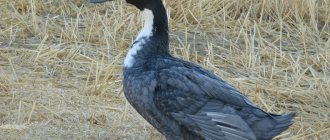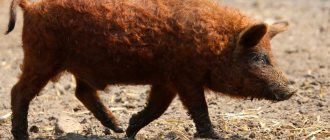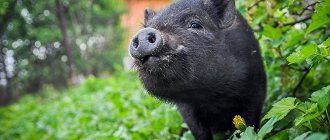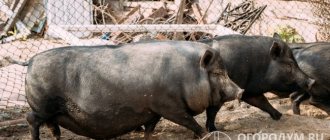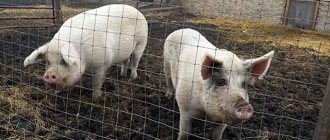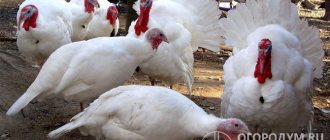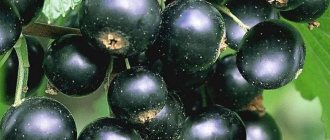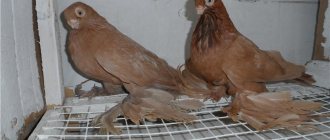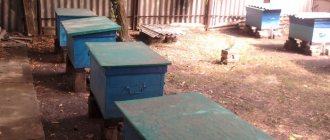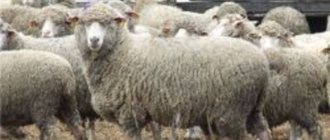Chinese Meishan pigs were developed more than 400 years ago. What is characteristic is that the breed has not changed much since that time. Animals still surprise with their exotic appearance, and also delight the owner with their unpretentiousness to food and high resistance to disease. The Chinese breed is not widespread in Russia, but still some breeders are breeding it.
Chinese Meishan pig
Breed history and habitat
Meishan is considered one of the most ancient breeds in the world. The first mentions of it are found in chronicles four hundred years ago. But in China there is a group of Taihu pigs, which gave rise to seven other breeds or breed groups: scientists are still arguing about the classification.
The breeds are very similar to each other morphologically and genetically, differing only in the areas of breeding. This prevents scientists from coming to a consensus on whether the various Taihu populations are separate breeds or just breed groups.
Meishan was named after a region in Southern China. But today, meishan is grown mainly in the Shanghai and Jiangsu areas.
The homeland of animals and, most likely, the entire Taihu group is in a subtropical climate. Unlike the European pig, which has virtually no ability to thermoregulate, the Meishan is perfectly adapted to the heat. Dark skin protects against sunburn. Large ears help dissipate heat.
Reproduction
Meishan is perhaps the most prolific pig in the world. The record number of piglets per sow is 22; there are also references to 40.
In this regard, Chinese piglets have practically no problems: the average farrowing rate is 12-18 piglets, which, as already mentioned, have excellent survival rate; farrowing can take place twice a year. A sow can relatively easily feed almost the entire farrow, since the number of her nipples reaches 8, 9 and even up to 12.5 pairs. Unlike the mother, the skin of piglets is relatively smooth.
Females can be considered ready for mating at the age of three months, while boars mature a little later, after about four months. Mating, however, is carried out in most cases only in the ninth month in order to increase the female’s chances of successfully bearing offspring.
Chinese funny pigs
After birth, babies begin to fight for a place near the mother's udder. Throughout the first week, the piglets fight for the milk nipples. The strongest babies settle near the front ones, while the weak ones remain the middle and rear ones, in which there is much less milk. It is also safer to be near the front teats; here the pig will not crush the sluggish piglets.
In order to get a full-fledged animal from each baby, the farmer needs to periodically change places of piglets near the nursing sow.
The health of a piglet can be judged by its tail; in a viable pet it is curled into a ring. An animal is sick if its tail hangs limply. They also monitor the surface of the baby’s body; a healthy piglet’s bristles are soft and glisten in the sun. The mouth and snout should be pink, and if the mouth turns blue, contact your veterinarian immediately.
How to take care of babies
Close to mom It is important for any beginning farmer to know how to handle Meishan piglets so as not to accidentally harm their health.
Chinese piglets are strongly attached to their mother.
The very first stress for babies is weaning from the sow.
After weaning, piglets may be agitated or depressed and begin to eat feed poorly, which affects weight gain.
You can approach the resolution of the situation in a different way. For this purpose, the pets are not taken from their home pen, but the sow is transferred from there. The kids will remain in familiar conditions, and adaptation will be almost painless.
What to do if you need to pick up a piglet? They grab him by the hind legs with one hand and lift him up by them, and with the other hand they support him under the chest.
The pet, which was grabbed by the sides, lets out a heart-rending squeal. The sow, hearing the piglet squeal, immediately attacks the person.
There are almost no representatives of the breed intended for slaughter on European territory. Most often, these pigs are kept in zoos and zoos. The animals cause a stir among visitors with their wrinkled faces, like crumpled skins, and drooping ears. Zoos advertise exotic animals to attract more guests. A sow with numerous funny piglets slowly walking along the paths also looks funny.
To raise and create living conditions for exotic breed pigs, you do not need to have special skills or use complex techniques.
Appearance, temperament
The Meishan may be confused with the more common Vietnamese pot-bellied pig. Experts even consider them related, since their common ancestor, the Asian wild boar, lived in China. Accordingly, Chinese, Vietnamese and Korean pigs are relatives, albeit distant ones.
Meishan looks uglier than a Vietnamese pig. The boar at night can be mistaken for a creature from horror films. These are massive animals of small stature with a rough constitution. They are classified as medium and small varieties of domestic pig.
The height of sows at the withers is up to 60 cm, boars - up to 70 cm. The body of sows is square in shape with a very drooping belly. Vietnamese pot-bellied pigs have a longer body. In Meishan boars, the belly is tucked and forms a horizontal lower line with the chest.
The large head is set well below the withers. Because of this, boars appear hunchbacked. In sows, this impression is smoothed out due to the sagging back. The snout is very short, with a large snout. There are many folds of skin on the head. The ears are hanging, very large. The average length of the auricle is up to 30 cm, but sometimes the tip of the ear can hang below the head.
Due to this size of ears, the Meishan pig avoids overheating. Through the blood vessels in the ears, these animals release excess heat to the external environment.
The neck is short and directed downwards. The leather on the body is gray or black. Pejins (spots) can be on the lower legs, belly and heel. For Meishan, folds are characteristic not only on the head, as is found in Vietnamese boars, but throughout the body. The legs are short and very powerful. The tail of Chinese pigs is straight and hanging. The color of the sparse, stiff bristles follows the color of the skin and is usually black. The feathers have light bristles.
Despite their terrifying appearance, Meishans are calm and fairly good-natured animals . Sows have a well-developed maternal instinct and in the first days after farrowing they can be aggressive towards strangers. The pig will protect the piglets from their owners only if they show a clear interest in the cubs. Chinese piglets in childhood are characterized by curiosity and somewhat destructive tendencies.
Breeding
Today, in addition to China, Meishans are bred in England, Canada, the USA and in certain European countries. They are mainly bred due to a number of advantages of the variety, which include:
- increased resistance to diseases and parasites;
- unpretentiousness in terms of diet and living conditions;
- easy heat tolerance;
- high quality meat and lard product;
- fertility;
- high percentage of piglet survival;
- long life of the animal;
- calm disposition, which makes it possible to keep pigs together with other inhabitants of the farm.
By nature, Meishans are unpretentious to living conditions, but it is better for breeders to follow some rules for breeding them. Already newborn piglets need to be looked after and carefully looked after.
From the first days, the offspring of this species begins to fight for the mother's udder, and the strongest babies get the front nipples, which contain more milk. Accordingly, those that are weaker are content with the less productive part of the udder, which means they grow more slowly. The animal owner's task is to balance the growth rate of the young animals by periodically manually replacing piglets at the milkier front teats.
Separating Meishan babies from their mother is very stressful
Also, when breeding piglets, it is important to consider the following nuances:
- The separation of Meishan babies from their mother is a great stress for them, which can affect their growth and development. To partially compensate for this, it is better to remove the female from the general housing pen rather than take the piglets.
- When kept with a sow, babies should be handled extremely carefully. If the cub is hurt and it squeals, the mother’s maternal instinct is triggered and she may attack.
- When examining the offspring, it is important to pay attention to the baby’s tail and nose. If the tail is not curled into a ring, and the snout has a certain blueness, it means that the baby is sick and it is better to show him to a specialist.
As for the remaining aspects of breeding, even a novice farmer can implement them. But buying such a pig in Russia is extremely problematic. There are practically no large enterprises engaged in breeding purebred individuals, and it is also not easy to find private farms that make money by breeding this breed.
Fertility
The only reason why breeders in the USA became interested in the Meishan breed was the very high fertility of sows. A batch of animals was even exported to America in 1989 to try to increase the fertility of industrial breeds of pigs through crossbreeding. The experiment was not successful and was discontinued in 2016.
The remaining pigs were distributed to farmers, where they “disappeared.” The reason for the failure today is considered to be that the fertility of the Meishan is determined by genetic and hormonal factors, which for some reason do not work in hybrids with Western breeds. Therefore, despite the high reproduction rate, in the West the meishan is more likely to be found in a zoo than on a farm.
At the same time, the fertility of animals is amazing. Puberty in pigs begins at 3 months. For boars - 5. An adult Meishan pig gives birth to 15-16 piglets per farrowing. You should not expect a large litter from a young pig. The first time she will bring 5-6 piglets . Sows have from 6 to 12 pairs of teats, so they are able to feed all the piglets. But usually no more than 12 heads are left under the pig, removing the weakest cubs.
Growing conditions
Despite the lack of special care requirements, certain points should still be taken into account when breeding Chinese pigs. Speaking about the optimal conditions for their cultivation, it is worth noting a number of requirements that apply to the room where they are planned to be bred:
- There must be a solid concrete foundation under the floor of the building and along the walls. Meishans have a natural habit of tearing up the soil and gnawing boards. Therefore, they can quickly render the barn unusable.
- Strong walls made of brick or foam block. If thin wood is used, they must be additionally insulated so that the barn does not freeze in winter.
- Availability of a high-quality ventilation system.
- Grooves in the floor for drainage of manure and urine.
- High quality heating. This point is especially important for premises where newborn piglets are kept.
- The machines must be made of iron, otherwise the pig will quickly chew through them.
The barn itself for raising pigs should consist of three main parts:
- The area where the pens are located and the pigs spend most of their time.
- Territory for herd walking. It should be partially blocked to provide shade.
- A wide but shallow reservoir of water where animals can escape the heat.
The size of the pen for representatives of the Chinese breed is calculated depending on the age and build of the individual. For each piglet you need at least 3 square meters. m. area, for an adult sow - from 4 to 6 square meters. m. The pen must include a rookery and a feeding trough.
Productivity
The weight of adult individuals ranges from 124 to 180 kg. Chinese piglets grow very slowly, reaching a weight of 100 kg after a year. But they begin to grow tall at an early age. In China, lard, leather and offal are valued rather than meat. Meishan is classified as a tallow breed of pig. They not only have a bacon thickness of 30-40 mm, but also very fatty meat.
Slow growth and large amounts of fat have become the main obstacle to raising Chinese pigs on Western farms. In terms of carcass yield, the Meishan is almost as good as elite Western breeds: 67%. The meat even tastes better than Western pig products.
Another disadvantage is the very large size of the internal organs, which are considered a delicacy in China. In Western countries, all pig entrails are often thrown away.
Productive Features
Meishan pigs are considered record holders in terms of fertility. There is a known case when a female gave birth to 22 cubs in one litter. The same sow once gave birth to 40 babies. However, such a case cannot be considered common - usually female meishans give up to 15–20 cubs per farrow.
Young pigs belonging to the Chinese breed are ready for mating after reaching the age of 4–5 months. This fact also affects the productivity of animals. However, it is recommended that males and females be mated only when young pigs are 9 months old . It is believed that this is the age at which the formation of the body is completed.
Meishans are famous for producing lard with high taste. This is facilitated by the physiological characteristics of animals:
- the presence of thick skin folds;
- saggy belly of impressive size;
- accumulation of fat from an early age.
Feeding and maintenance
The advantage of Chinese pig breeds is their unpretentiousness and resistance to diseases. Aboriginal breeds have never had special conditions, so they adapt well to eating pasture.
You can feed them:
- roughage: hay and straw;
- flour milling waste;
- mixed feed;
- seaweed (Chinese recipe);
- dairy products;
- succulent food: root vegetables, potatoes, fresh grass.
The “Chinese” are able to assimilate and benefit from any food. Their need for feed per kilogram of weight gain is 40% lower than that of “Western” pigs. The only warning: Chinese pigs are easily poisoned by fruits and vegetables from supermarkets . The bodies of these animals cannot tolerate high levels of chemicals in store-bought products.
Caring for animals is not difficult, provided that their housing is spacious enough. Animals are very clean and choose a specific place for the toilet. They leave the rest of the litter clean. It is enough to clean the “toilet” every day so that there is not even a smell in the pigsty.
As a southern breed, Meishan require an insulated pigsty, but they are not as fastidious as Western meat breeds. Piglets survive at air temperatures not lower than +20°C. If the temperature is +10-15°C, weak young animals may freeze. Adult pigs tolerate such “cold weather” well.
Chinese piglets
Chinese Meishan pigs were developed more than 400 years ago. What is characteristic is that the breed has not changed much since that time. Animals still surprise with their exotic appearance, and also delight the owner with their unpretentiousness to food and high resistance to disease. The Chinese breed is not widespread in Russia, but still some breeders are breeding it.
Chinese Meishan pig
Prospects of the breed
For industrial pig farming, meishan has no practical significance. Outside of China, purebred pigs are bred by exotic or lard lovers. But Western breeders do not lose hope of benefiting from this breed. Meishan could be very valuable from a genetic engineering perspective. Even in China, work is now underway to reduce greasiness in pigs.
Genetic modification can produce results where conventional selection failed. If rapid growth can be achieved while maintaining multiple births, unpretentiousness and disease resistance, Meishan will take its place in the Western pork market.
Author: Olga Zadorozhnaya
A few care tips
Maintaining meishans is not particularly difficult. This breed of pigs is famous for its excellent health and calm disposition, so even those farmers who have little experience in animal husbandry can breed them. However, there are features, and you should be aware of them in order to avoid unnecessary mistakes.
First of all, a pigsty for meishans must be strong and stable. This condition is dictated by the peculiarities of their behavior - these pigs love to dig the ground under walls. It is impossible to wean the Meishans from this; it is inherent in them at the genetic level. The pigsty must be arranged in such a way that its walls do not allow cold air to pass through. It is also necessary to consider an effective ventilation system so that fumes from animal excrement are removed from the premises.
It is better to use cinder block or brick as building materials for a barn, as they have good thermal insulation characteristics. The size of the pigsty will directly depend on the size of the herd, but approximately 2 m of space should be allocated per individual.
